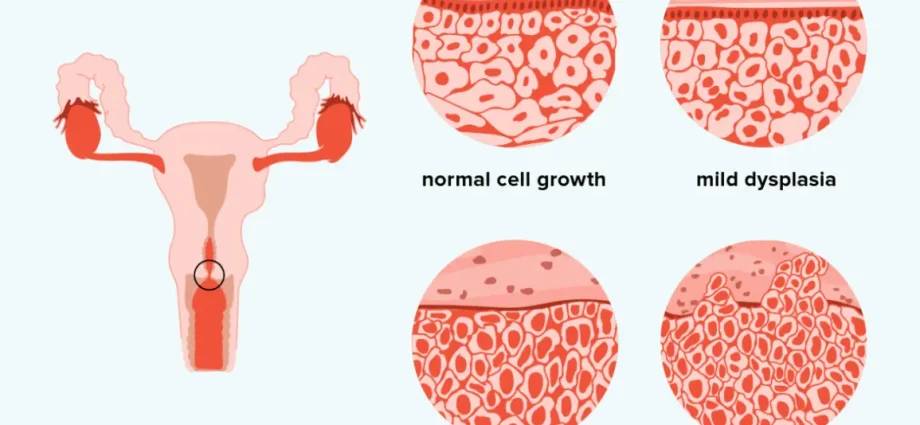Contents
What is cervical dysplasia
Cervical dysplasia is a precancerous condition. Unfortunately, the presence of this diagnosis suggests that women and girls are more likely to get cancer. But it is worth remembering that oncology does not develop from 100% of cases, so there is no need to panic. With cervical dysplasia, pronounced hyperplasia (thickening), proliferation (growth), impaired differentiation, maturation, aging and rejection of cervical epithelial cells occur.
Depending on the severity of certain disorders listed above, there are three degrees of cervical dysplasia:
- mild cervical dysplasia;
- moderate cervical dysplasia;
- severe cervical dysplasia.
The degree of cervical dysplasia is determined by the doctor according to the depth of penetration of the pathological process – violations of cellular transformations in the layers of the epithelium.
Causes of cervical dysplasia
The main cause is considered to be infection with the human papillomavirus, HPV. This virus has about 200 subtypes, some of which have carcinogenic properties. Subtypes 16 and 18 cause 70% of precancerous and cancerous diseases of the cervix, other strains cause genital warts or condylomas. HPV infection occurs only through sexual contact.
Risk factors for HPV include:
- the beginning of sexual activity before the age of 18;
- childbirth before 16 years;
- a large number of sexual partners, promiscuity;
- diseases associated with a decrease in immunity. For example, HIV, diabetes;
- the use of drugs that suppress the immune system;
- refusal of condoms. This method of protection cannot completely protect against infection with viruses, however, it reduces the risk of infection;
- smoking.
Symptoms of cervical dysplasia
Unfortunately, the disease can sometimes be asymptomatic. The patient may not be disturbed by anything, and at the reception she learns about the presence of cervical dysplasia. That is why it is important to visit a gynecologist every six months.
However, symptoms sometimes appear:
- discharge from the genital tract: most often with cervical dysplasia, the discharge is abundant, white-colored, has an unpleasant odor;
- the appearance in the secretions of streaks of blood after intercourse or the use of tampons;
- pain during sexual intercourse;
- pulling pains in the lower abdomen: they usually occur with a severe form of cervical dysplasia.
Treatment of cervical dysplasia
In no case should you self-medicate – on the advice of friends or the Internet. A woman goes to a doctor who, depending on the history and stage of cervical dysplasia, prescribes treatment. The method of treatment depends on the diagnostic results, age and well-being of the patient. Physicians develop individual methods of treatment.
After the gynecologist makes a diagnosis, determines the degree of damage to the cervix, he will choose what the treatment of cervical dysplasia will be.
There are two methods of treating cervical dysplasia: medical and surgical.
Diagnostics
The Pap test is considered the simplest and most informative test, otherwise it is called a Pap smear, a smear for cytology, a smear for atypical cells.
A smear is taken from the surface of the cervix during the examination, this is a painless procedure. Then the laboratory assistant examines the shape, size, quantity, location, composition of cells under a microscope. The study must be carried out annually, starting at the age of 18. Unfortunately, most neglect this.
If atypical cells are found in the Pap test, a biopsy is performed. To do this, an optical system, a colposcope, is inserted into the vagina. It helps the doctor to see the most altered areas and take a piece of tissue.
Therapies
How to treat cervical dysplasia should be determined only by a doctor and only after a comprehensive examination.
Drug treatment. It is prescribed if a woman has mild dysplasia. A gynecologist prescribes drugs that suppress proliferative activity, have antiviral and immunomodulatory effects.
There is also a waiting strategy. It is practiced if the age of the patient does not exceed 20 years. Surveillance tactics involves a mandatory examination by colposcopy at least twice a year, in order to timely identify if the disease begins to progress. This tactic is also used if there are no concomitant diseases, viral infections.
In the severe stage of cervical dysplasia, it is customary to use surgery of this disease. The operation is carried out after a comprehensive examination, the inflammatory process must be eliminated without fail. The method of surgical intervention is determined depending on the degree of cervical dysplasia diagnosed. Amputation can be used as a last resort. Also, if the patient’s age indicators do not imply the preservation of reproductive function.
Prevention of cervical dysplasia at home
In order for the treatment of cervical dysplasia to be successful and the disease does not recur, a woman must undergo a follow-up preventive examination after 3-4 months, which allows you to check how the healing went. The doctor will conduct a histological examination of a smear taken from the surface of the cervix. If the analysis shows that everything is in order, then it is enough to repeat the examination once a year.
The main measure to prevent the appearance of dysplasia at home is to strengthen the immune system, increase the body’s resistance. To do this, you need to give up bad habits. You need to eat right, fight the lack of vitamins, engage in physical activity.
It is important to consult a doctor in time and be treated in the presence of diseases of the genital organs. Regular examination of the cervix is the main tool to prevent the development of this insidious disease. Therefore, it is recommended that all women take care of their health in a timely manner.
Popular questions and answers
Answers Natalya Belyaeva – obstetrician-gynecologist of the highest qualification category:










